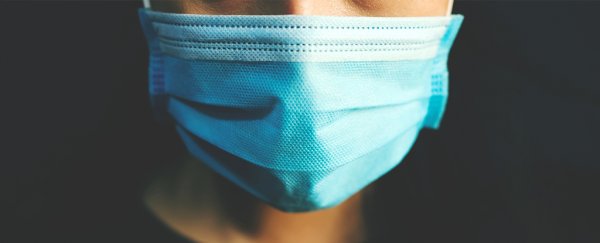Face masks help reduce the transmission of SARS-CoV-2 by interfering with the spread of virus-laden droplets ejected from the nose and mouth.
Recommendations on the use of masks have varied over the course of the pandemic, depending on available data on the virus's transmission. This has complicated the discussion over who should wear face coverings and when they should be worn.
Evidence supporting their general effectiveness in public settings has mounted steadily with ongoing research on infection rates around the globe, prompting health authorities to now advise citizens in high-risk communities to wear some kind of lower face covering while out in public.
The Centers for Disease Control and Prevention in the US currently recommends "that people wear cloth face coverings in public settings and when around people who don't live in your household."
Similarly, the World Health Organisation advises it is "prudent to encourage the use of fabric face masks in public places where there is community transmission."
Local authorities around the world have also implemented mandatory measures for wearing masks, imposing fines in specific circumstances to help reduce the virus's spread, and adding incentive for all individuals to wear a mask while in public.
How do face masks work?
Current research on the transmission of the SARS-CoV-2 virus now emphasises that it is an airborne illness. This means the virus can be found in numbers sufficiently large to pose a risk when expelled inside droplets small enough to drift a reasonable distance and reach new hosts.
This is in contrast to previous assumptions that the virus is predominantly found in larger droplets that are capable of only travelling a limited distance, or are primarily transferred through touching contaminated surfaces.
While neither mode of transfer can be ruled out, controlling the spread of a pathogen through a community is a numbers game. The greater the number of airborne virus particles hanging around over any given period of time, the greater the chance one will make it into another person's airway.
That single jump of just one particle can be disastrous. SARS-CoV-2 is considered to be a superspreader pathogen - large outbreaks of the illness are typically the result of single transmission events. Blocking a single act of transmission has the potential to prevent a large number of new infections.
Do I need to wear a face mask if I don't feel sick?
While there's ongoing debate over precise numbers, it's likely that nearly half of all people infected with SARS-CoV-2 (if not more) do not experience any symptoms.
These asymptomatic carriers of the virus continue to shed the pathogen as they breathe, without any knowledge of their doing so.
Without a clear way to determine who is infected and who isn't, a population can keep infection rates down by assuming everybody is capable of transmitting the virus.
In other words, everybody should wear a mask to protect their community. Even if you're certain there's no chance you're carrying the virus, wearing a mask is a sign of solidarity, making its use more acceptable to others.
What kind of face mask should I wear?
The nature of the weave or mesh of fabric making up a mask, as well as its closeness of fit against the face, determine the chances droplets will exit an infected person and make it into a new host by intercepting its movement before it even has a chance to get airborne.
Any kind of fabric in front of the nose and mouth is considered to be better than no barrier at all. You can read a comparison of different face masks here.
Will a face mask make it harder for me to breathe?
No. There is no evidence that wearing a mask for even prolonged periods significantly compromises oxygen for a healthy wearer, or reduces their ability to release carbon dioxide.
All Explainer articles are determined by fact-checkers to be correct and relevant at the time of publishing. Text and images may be altered, removed, or added to as an editorial decision to keep information current.
